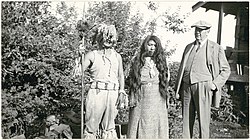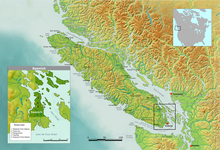
Back Saanich (Volk) German Saniĉoj Esperanto Saanich Croatian Saanich Italian Saanich Serbo-Croatian
This article includes a list of general references, but it lacks sufficient corresponding inline citations. (November 2017) |
 Elsie Copper and her brother, who is wearing traditional Saanich dance regalia. George Gustav Heye, right. 1938 photo, NMAI. | |
| Regions with significant populations | |
|---|---|
| ( | |
| ( | |
| Languages | |
| English, Saanich | |
| Religion | |
| Christianity, Animism | |
| Related ethnic groups | |
| Coast Salish | |
| People | W̱SÁNEĆ |
|---|---|
| Language | SENĆOŦEN |
| Country | ÁLEṈENEȻ (TŦE W̱SÁNEĆ)[1][2][3] |

The Saanich or W̱sáneć (Saanich: W̱SÁNEĆ, [xʷˈsenət͡ʃ], Xwsenəč) are indigenous nations from the north coast of the Gulf and San Juan Islands, southern Vancouver Island and the southern edge of the Lower Mainland in British Columbia.
The W̱SÁNEĆ (weh-saanich) peoples are represented by the Tsartlip (Sart-Lip), Pauquachin (Paw-Qua-Chin), Tsawout (Say-Out), Tseycum (Sigh-Come) and Malahat (Mal-a-hat) Nations.[4] The W̱SÁNEĆ Leadership Council Society consists of three of theses Nations: Tsartlip, Tseycum and Tsawout.[5] These W̱SÁNEĆ First Nations remain on their ancestral lands.
- ^ "Á,LEṈENEȻ ȽTE – Our Homeland". W̱SÁNEĆ Leadership Council. W̱SÁNEĆ Nation. Retrieved 7 November 2023.
- ^ "SENĆOŦEN Survival School". W̱SÁNEĆ School Board. W̱SÁNEĆ Nation. Retrieved 7 November 2023.
- ^ W̱SÁNEĆ School Board; Swallow, Tye (30 November 2018). "Chapter 9 – Learning from the Homeland: An Emerging Process for Indigenizing Education". In Williams, Wanosts'a7 Lorna; Snively, Gloria (eds.). Knowing Home: Braiding Indigenous Science with Western Science, Book 2. ePublishing Services, University of Victoria Libraries.
ÁLEṈENEȻ means "homeland" in the SENĆOŦEN language.
- ^ "Indigenous Relations". Saanich.ca. Retrieved July 22, 2021.
- ^ "W̱SÁNEĆ Leadership Council". W̱SÁNEĆ. Retrieved December 10, 2020.